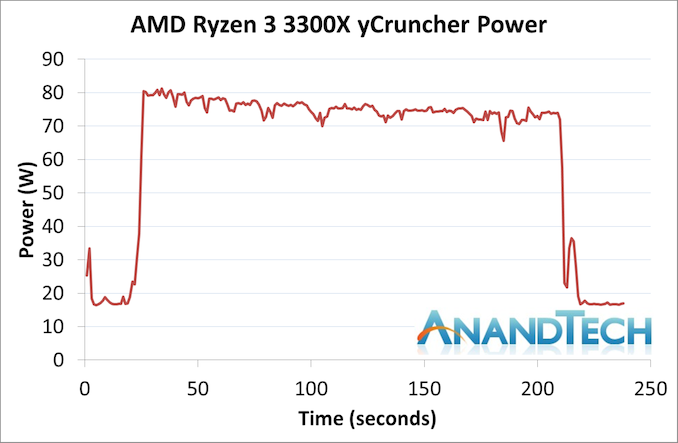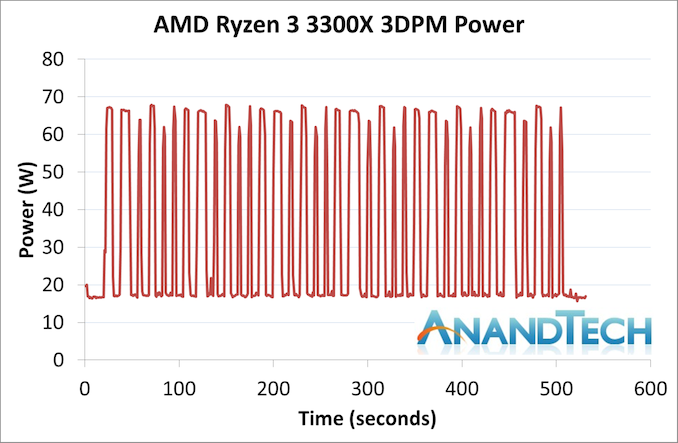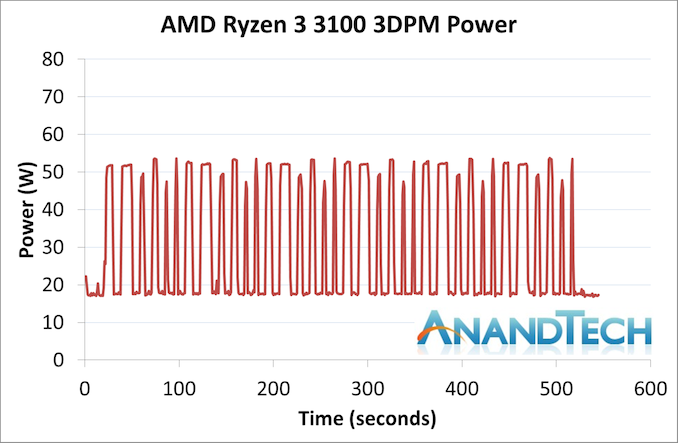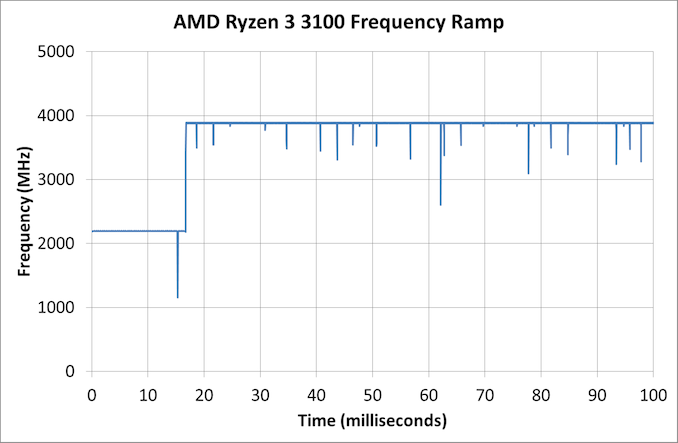The AMD Ryzen 3 3300X and 3100 CPU Review: A Budget Gaming Bonanza
by Dr. Ian Cutress on May 7, 2020 9:00 AM ESTPower Consumption and Frequency Ramps
On the box, both processors are listed as having 65 W TDPs. With its Zen-based hardware, AMD has been relatively good at staying around that official on-the-box value, even during turbo. In the last generation, AMD introduced a feature called PPT, or Package Power Tracking.
- For 105 W processors, PPT is >142 W
- For 65 W processors, PPT is >88 W
- For 45 W processors, PPT is >60W
This allows the processor to raise its power limits, assuming it isn’t breaching thermal limits or current limits, and consequently raise the frequency. As a result, while we see 65 W on the box, the real world power consumption during most tasks is likely to be nearer 88 W, unless the current or thermal lines are crossed.
As a new element to our testing, we are recording power over a number of benchmarks in our suite, rather than just a simple peak power test.
AMD Ryzen 3 3300X
For the faster chip, we saw a peak power in both of our tests of around 80 W.
With yCruncher, which is somewhat of a periodic load, the power consumption dropped over time to nearer 75 W.
3DPM is more obvious with its idle steps between loads, being 10 seconds on then 10 seconds waiting. The power almost peaked at a similar amount here.
In both of these graphs, the package power when idle is around 16-17 W. I looked back through the data, and noticed that out of this power only 0.3 W was actually dedicated to cores, with the rest being towards the big IO die, the memory controllers, and the Infinity Fabric. That’s still pretty substantial for an idle load.
At low loads, the power per core was around 14 W, while at full load it was slightly less depending on the test. This is a bit away from the 20 W per core we get from the high end Zen 2 processors, but these only go to 4.3 GHz, not 4.7 GHz+. This is about in line with what we expect.
On our frequency ramp test, the Ryzen 3300X went from an idle state to peak power within 17 milliseconds, or approximately a frame at 60 Hz.
One of the new features with Ryzen 3000 is CPPC2 support, which AMD claims to reduce idle-to-turbo ramping from 30 milliseconds to 2 milliseconds. We’re seeing something in the middle of that, despite having all the updates applied. That being said, the jump up to the peak frequency (we measured 4350 MHz, +50 MHz over the turbo on the box) is effectively immediate with zero skew across a range of frequencies.
AMD Ryzen 3 3100
Given that the TDP number on the side of the box says 65 W as well, any reasonable user would assume that the power of this chip would be equal, right? Regular readers will know that this isn’t always the case.
In our yCruncher test, because the turbo frequency is lower than the 3300X, it means the voltage can be lower, and thus power is lower. Our history of testing Zen 2 has shown that these cores get very efficient at lower frequencies, to the point where our processor doesn’t even break that 65 W threshold during yCruncher.
Similarly the 3DPM peaks are also lower, barely going to 55 W during an AVX2 workload.
On the frequency ramp side, we see another instance of a 16-17 ms transition.
Summary
For the peak power out of all of our testing, we saw the Ryzen 3 3300X hit a maximum of 80 W, and the Ryzen 3 3100 go to 62 W. When we compare that to the Core i7-7700K, at 91 W TDP / 95 W peak, combined with most of the results on the next few pages, AMD by comparison is more efficient.
















249 Comments
View All Comments
PeterCollier - Monday, May 11, 2020 - link
Did you really feel the need to add 40 comments a week later the article was published? And on a Monday? Please tell us what company, Intel or AMD, that you work for.Spunjji - Tuesday, May 12, 2020 - link
Yes, reading article comments five days "late" definitely indicates that I work for a tech company, and not that I only visit this place once or twice a week during my lunch break. But hey, basing trolls is what I do for amusement. What's your excuse for trolling in the first place?kepstin - Friday, May 8, 2020 - link
I suspect that the 2600 was put into the charts as a stand-in for the 1600AF. The 1600AF should perform very close to the 2600 in most benchmarks - just a touch slower due to reduced clock speeds.rabidpeach - Friday, May 8, 2020 - link
1600af is represented by the 2600. the 2600 is just slightly better than it. this is not a problem. also amazon is out of them. the only benchmarks these processors win are high core count. daily life the 100 3100 will be faster so why hobble yourself with the smaller cache and 12nm?DanNeely - Thursday, May 7, 2020 - link
Something I've been wondering about for a while, is that when the first Ryzen announcements were made I read articles saying that the inclusion of some SATA/USB on the CPU itself would allow for cheaper entry level mobos/systems that used the CPU as an SoC without a chipset at all. However I don't recall ever seeing anything built that way. I'm inclined to doubt that it is possible but that no one has ever done it because for a low end system without a discrete GPU the CPU appears to have enough IO to cover all the bases. Were the initial reports wrong? Is it something that's only shown up in cheap OEM systems but never DIY boards?neblogai - Thursday, May 7, 2020 - link
Deskmini A300 is made this way- althouth it has no dGPU slot and requires an APU. This also allows the PC to idle at just 8-10W, compared to ~20W(?) for PCs that use motherboards with chipsets.DanNeely - Friday, May 8, 2020 - link
just one system by a single vendor. Kinda disappointing IMO since the CPU has enough connectivity for a basic no frills system, and would've been a reasonable option for a budget mITX board.Spunjji - Monday, May 11, 2020 - link
Agreed. I'd love to build a system in my existing USFF ITX case using something like an ITX version of the Deskmini A300 board, but for some reason nobody's doing it. I'm genuinely cluesless as to what "some reason" might be, too, as the A300 proves the concept just fine.Slash3 - Thursday, May 7, 2020 - link
ASRock's DeskMini A300 series systems are the closest configuration to this, lacking a secondary chipset.notb - Thursday, May 7, 2020 - link
A lot of focus in this text is about how 3300X ($120) compares to 7700K ($329, 3 years ago).Wouldn't it be nice to see how 3300X compares to high-end original Ryzen? ;)
The choice of CPUs is really weird. 8086K? 4790K? Really?
1600X, 1700, 1700X, 1800X - all probably beaten in most games and synthetic single-thread. In a lot of software as well (since 7700K used to beat 1800X occasionally).
1800X: $499